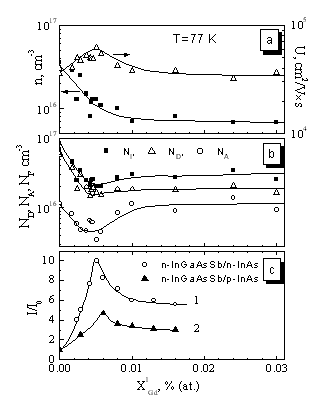The capabilities of liquid-phase epitaxy
technology (LPE) in application to the fabrication of efficient optoelectronic devices,
including those based on III-V solid solutions, are often known to be limited by the
presence of residual silicon, carbon, and oxygen impurities in the melt. Of special
interest in this regard are works in which possible avenues are offered for the
purification of semiconductor materials doped with rare-earth elements Yb, Gd, Sc, Sm,
etc. The objective of the part of our work was to prepare and investigate the electrical
and luminescent properties of narrow-gap solid solutions n-InGaAsSb, grown by LPE from the
gadolinium-doped melt on the basis of these solid solutions and emitting in the spectral
interval l =3-5 mm.
The samples were epitaxial layers of the solid
solution n-InGaAsSb of thickness d=10-20 mm grown from the
Gd-doped melt in the range of concentration 0<XlGd<0.14 at.%. The density of free carriers n
decrease as the Gd content in the melt is increased (Fig.a). The most abrupt decrease,
from n=(3-6)*1016 cm-3 to n=1*1016 cm-3, is
observed in the interval 0< XlGd<0.005 at.%. When the Gd content in the
solution is further increased to XlGd=0.14 at.%, the n=f(XlGd)
curve reaches saturation, attaining values n=(7-8)*1015 cm-3.
Concurrently, at XlGd=0.005 at.% the electron mobility U increases
1.5-1.8 fold relative to mobility in the undoped samples, attaining value of U=61500 cm2/V* s at n=1.3*1016 cm-3 (Fig.a). Using the
results of the Hall measurements and assuming that the carrier mobility is mainly
determined by scattering at optical phonons and impurity ions, we have calculated the
densities of impurity ions (NI), donors (ND), and acceptors (NA).
An analysis of the results shows that the densities of impurity ions decrease
significantly with increase in the Gd content in solution, attaining minimum values ND=(1-2)*1016 cm-3 and NA=(3-5)*1015
cm-3 at XlGd=0.005 at.% (Fig.b). It can be attributed to
a decrease in the background impurity concentration of group-VI elements due to their
interaction with the gadolinium and the formation of high-melting compounds. With Gd
doping at XlGd=0.004-0.005 at.% a 4 to
10-fold increase in photoluminescence intensity (Fig.c) and a 1.3 to 1.8-fold decrease in
the half-width of spectra are observed relative to the undoped samples. It confirms the
conclusions as to purifying effect, based on galvanomagnetic measurements. |
|
 |